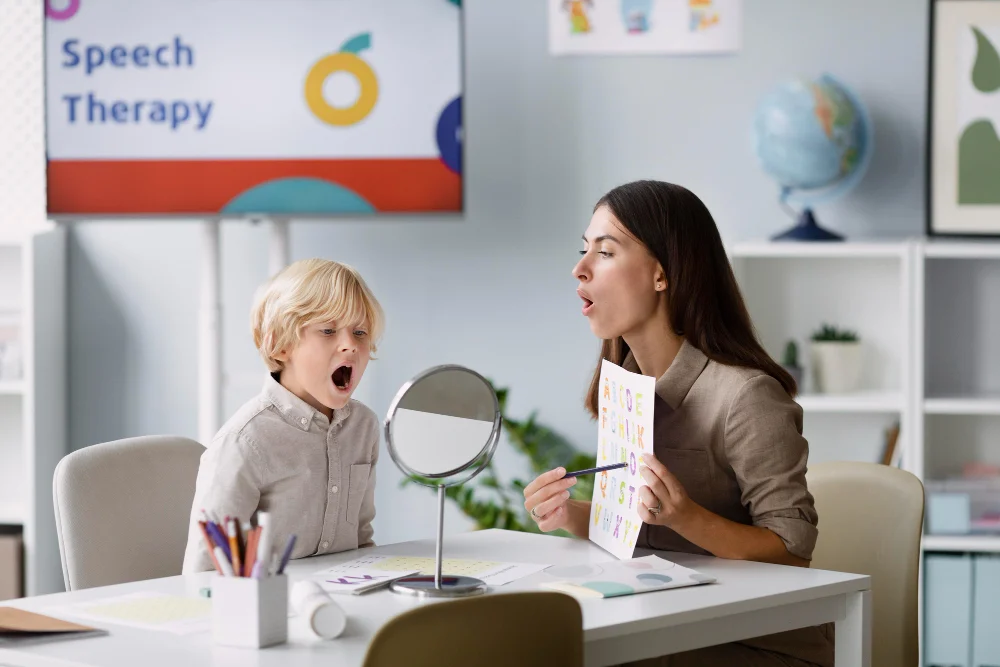“Can I really help my child with speech therapy at home, or am I just making it worse?”
That’s exactly what ran through my mind the first time a speech-language pathologist handed me a list of home exercises for my son. At the time, I felt overwhelmed. I wasn’t a therapist, I had no formal training, and I feared I’d get it wrong.
But here’s what I learnt: Speech therapy at home doesn’t mean replacing a professional. It means reinforcing what’s learned in therapy and creating a supportive environment that encourages communication.
In this guide, I’ll walk you through how to do speech therapy at home in a way that’s not only effective but also empowering. Whether you’re supporting a child with a speech delay or an adult recovering from a stroke, the steps here are grounded in expert recommendations and real-world experience.
Understanding the Role of At-Home Speech Therapy
Speech therapy at home isn’t about playing doctor. It’s about partnership.
According to the Royal College of Speech and Language Therapists (RCSLT), home involvement significantly improves outcomes. In fact, studies have shown that when parents are actively involved in speech therapy, children can make faster and more lasting progress.
So, how do you begin? Start by understanding your role. You’re there to:
- Reinforce what’s taught in professional sessions
- Create daily opportunities for practice
- Provide encouragement and positive reinforcement
Step 1: Consult a Licensed Speech Therapist First
Before doing anything at home, get a formal assessment.
Why it matters:
Each speech challenge is different—some stem from articulation issues, others from motor speech disorders, language delays, or neurological conditions. A licensed therapist will identify the specific areas of concern and design a treatment plan.
Once you have this plan, you’ll be able to tailor your home-based activities around it. Don’t skip this step.
Tip: Ask your therapist for homework or exercises specifically designed for home use. Many offer printable worksheets, app recommendations, or video tutorials.
Step 2: Set Up a Distraction-Free Speech Zone
Environment matters. Children (and adults) need a safe, quiet space where they can concentrate.
Here’s what worked for me:
- A small desk with no TV or tablets nearby
- Flashcards on the wall with frequently practised words
- A mirror (especially useful for articulation practice)
Remember: It’s not about making your home look like a clinic—it’s about reducing distractions and making room for engagement.
Step 3: Make It Routine, Not a Chore
Repetition builds mastery—but forced repetition builds frustration.
Instead of setting up an intense daily “speech class,” blend speech therapy into your everyday activities:
- Meal Times: Label food items, describe textures, talk about taste.
- Story Time: Pause and ask your child to describe what’s happening in the pictures.
- Play Time: Choose games that encourage speaking (e.g., “Guess Who,” storytelling dice, role-play).
One trick I used: Narrate your day.
For example: “Now I’m cutting an apple. What colour is it? Shall we cut it in half or quarters?” This models speech and vocabulary naturally.
Step 4: Use Tools Backed by Research
Some tools are fluff; others are gold. Here’s what speech therapists I spoke to recommend:
1. Apps
- Articulation Station (iOS): Offers structured activities for different sounds
- Speech Blubs (Android/iOS): Uses videos of kids to encourage mimicking
2. Flashcards & Visuals
Visuals help reinforce meaning and build vocabulary.
Pro tip: Create your own flashcards using family photos. This adds personal relevance and boosts engagement.
3. AAC Devices (if recommended)
For non-verbal children or adults, Augmentative and Alternative Communication devices (AAC) can support expression. Only use if guided by a therapist.
Step 5: Focus on One Sound or Goal at a Time
Don’t try to tackle everything at once. Work on one target sound, word group, or communication goal.
For example, if your child is working on the “S” sound, avoid switching to “R” or “L” just because they struggle there too.
Why? Speech development is like scaffolding. You build stability step by step.
Step 6: Record Progress and Celebrate Wins
Keep a small notebook or use an app to track:
- Words/sounds mastered
- Duration of daily practice
- Challenges or regressions
This will not only help your therapist adjust the plan, but also remind you both how far you’ve come.
Small win idea: When your child masters a sound, have a mini celebration—a star on a chart, a high-five, or letting them pick the next game.
Step 7: Stay Patient—and Have Fun
Progress can be slow. Plateaus are normal. Celebrate effort as much as achievement.
As one NHS speech therapist told me: “The goal isn’t perfect pronunciation. It’s confident communication.”
This changed my mindset entirely.
Common Mistakes to Avoid
- Overcorrecting: Too much correction can reduce confidence
- Skipping professional guidance: DIY without diagnosis is risky
- Making it too academic: Speech therapy should feel playful
FAQs
Q: Can I do speech therapy at home without a therapist?
A: You can support therapy at home, but it’s best done with professional guidance. A therapist can provide a roadmap tailored to your needs.
Q: How much time should I spend each day?
A: 15–30 minutes daily is often enough—consistency matters more than length.
Q: Is it too late to start speech therapy in adulthood?
A: Not at all. Adults recovering from strokes or neurological conditions can benefit immensely from consistent home practice.
Q: What if my child resists?
A: That’s normal. Keep it playful and don’t force it. Try incorporating speech activities into games they already enjoy.
Final Thoughts: You’ve Got This
Supporting someone’s speech journey at home isn’t about perfection—it’s about presence.
By showing up, creating space, and celebrating small wins, you’re laying the foundation for lasting communication skills.
Have you tried speech therapy at home? What worked best for you? Share your experience below—I’d love to hear it.
Further Reading & Resources
- Royal College of Speech and Language Therapists
- NHS Speech Therapy Services
- American Speech-Language-Hearing Association
Call to Action:
If you found this guide helpful, share it with a fellow parent or caregiver. Or drop a comment—what’s your biggest challenge with at-home speech therapy?




